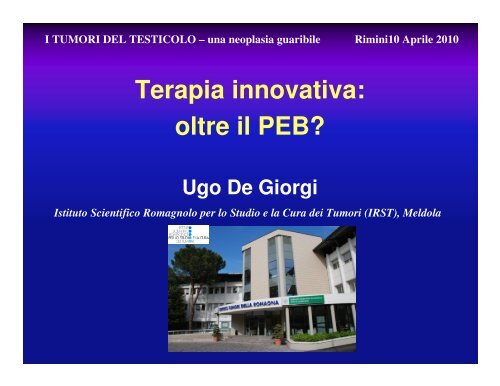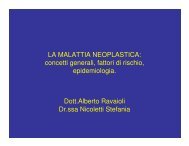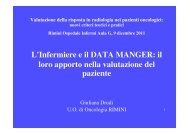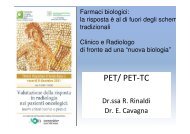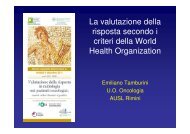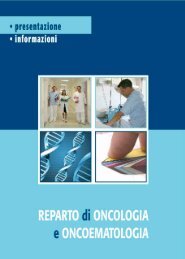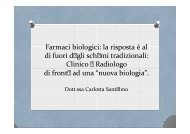Terapia innovativa: oltre il PEB? Relatore: Dr ... - Oncologia Rimini
Terapia innovativa: oltre il PEB? Relatore: Dr ... - Oncologia Rimini
Terapia innovativa: oltre il PEB? Relatore: Dr ... - Oncologia Rimini
You also want an ePaper? Increase the reach of your titles
YUMPU automatically turns print PDFs into web optimized ePapers that Google loves.
I TUMORI DEL TESTICOLO – una neoplasia guarib<strong>il</strong>e <strong>Rimini</strong>10 Apr<strong>il</strong>e 2010<br />
<strong>Terapia</strong> <strong>innovativa</strong>:<br />
<strong>oltre</strong> <strong>il</strong> <strong>PEB</strong><br />
Ugo De Giorgi<br />
Istituto Scientifico Romagnolo per lo Studio e la Cura dei Tumori (IRST), Meldola
Classificazione per <strong>il</strong> trattamento chemioterapico di prima linea<br />
IGCCCG (International Germ Cell Cancer Collaborative Group)<br />
Non-seminoma<br />
Buona Prognosi<br />
Seminoma<br />
T. primitivo gonadico o retroperitoneale e<br />
Assenza metastasi viscerali extrapolmonari e<br />
AFP
Sopravvivenza. Nuove stime aggiornate!<br />
Van Dijk et al - EJC 2006<br />
IGCCCG 1975-1990 10 Studi 1989-2001<br />
Non-seminoma<br />
Buona Prognosi<br />
5-y OS: 92%<br />
Non-seminoma<br />
Buona prognosi<br />
5-y OS: 94%<br />
+ 2%<br />
Non-seminoma<br />
Prognosi Intermedia<br />
5-y OS: 80%<br />
Non-seminoma<br />
Prognosi Intermedia<br />
5-y OS: 83%<br />
+ 3%<br />
Non-seminoma<br />
Cattiva prognosi<br />
5-y OS: 48%<br />
Non-seminoma<br />
Cattiva prognosi<br />
5-y OS: 71%<br />
+ 23%!
Sopravvivenza. Nuove stime aggiornate!<br />
Van Dijk et al - EJC 2006<br />
Miglioramento dei risultati nei pazienti con<br />
cattiva prognosi verosim<strong>il</strong>e espressione di:<br />
1. Migliori strategie terapeutiche (mantenimento<br />
corretta dose-intensity - ut<strong>il</strong>izzo di fattori di crescita<br />
G-CSF)<br />
2. Maggior esperienza dei medici nel trattamento dei<br />
tumori germinali, in particolare nei cattiva prognosi<br />
(corretto numero di cicli, chirurgia del residuo, ecc)
Trattamento di prima linea<br />
Conclusione<br />
Buona prognosi: <strong>PEB</strong> x3<br />
Prognosi intermedia e sfavorevole: <strong>PEB</strong> x 4<br />
PEI x 4 alternativa per pz con problemi respiratori o atleti
Trattamento di prima linea<br />
Residuo di malattia<br />
Il residuo di malattia deve essere sempre operato<br />
In caso di residuo (marker neg) non operab<strong>il</strong>e radicalmente<br />
- Follow-up serrato e seconda linea a eventuale progressione<br />
- NO 5° e/o 6° ciclo di <strong>PEB</strong> o PE!!<br />
- NO intensificazione/consolidamento con chemio alte dosi!!
Trattamento di prima linea - Residuo di malattia<br />
In caso di cellule vitali nel residuo di malattia<br />
Conclusion: In patients with post-chemotherapy viable NSGCT, a complete resection<br />
of residual masses should be rigorously pursued. These data validate the sCR1<br />
prognostic index. Given their excellent outcome, patients in the favorable group (good<br />
risk, complete resection, VMC
NJ van As, et al. Evidence-based pragmatic guidelines for the<br />
follow-up of testicular cancer. Br J Cancer 2008 98: 1894–1902
Trattamento di seconda linea<br />
Circa <strong>il</strong> 30-40% dei GCT avanzati, non vengono<br />
curati con chemioterapia di prima linea…….<br />
….ma di questi circa <strong>il</strong> 50% dei seminomi e <strong>il</strong><br />
25-45% dei nonseminomi vengono curati con<br />
chemioterapie di seconda linea
Trattamento di seconda linea<br />
- VeIP (cisplatin, ifosfamide, vinblastina)<br />
Loehrer PJ & Einhorn LH. J Clin Oncol. 1998.<br />
- VIP (o PEI) (cisplatin, ifosfamide, etoposide)<br />
Harstrick A & Schmoll HJ. J Clin Oncol. 1991.<br />
Pizzocaro G & Salvioni R. Ann Oncol. 1992.<br />
Sopravvivenza disease-free a 4-5 anni: 25-42%<br />
TIP (cisplatin, ifosfamide, paclitaxel) con G-CSF<br />
Kondagunta V & Motzer R. J Clin Oncol. 2005.<br />
Sopravvivenza disease-free a 2 anni: 65%!!!<br />
…ma pazienti selezionati
Outcomes with second-line salvage therapy for recurrent germ cell tumors<br />
+G-CSF<br />
Sonpavde, G. et al. Oncologist 2007;12:51-61
Pazienti trattati in seconda linea<br />
IT-94 Study - Sopravvivenza libera da malattia<br />
(Pico, Rosti et al – Ann Oncol 2006)<br />
1<br />
4PEI 3PEI+PEC<br />
.8<br />
PROBABILITY<br />
.6<br />
.4<br />
.2<br />
0<br />
0 1 2 3 4 5 6<br />
YEARS
Pazienti trattati in<br />
seconda linea<br />
Ruolo della<br />
chemioterapia<br />
alte dosi (HDCT)<br />
Lorch A et al – Randomized<br />
study of Single vs Sequential<br />
HDCT – JCO 2007
Prognosi alla ricaduta/progressione dopo 1a linea<br />
Si tratta di una popolazione di pazienti poco<br />
numerosa e altamente eterogenea.<br />
La maggior parte di questi pazienti viene trattata<br />
con chemioterapia di salvataggio seguita da<br />
chirurgia del residuo, se necessario<br />
I fattori prognostici possono avere un elevato<br />
impatto sui risultati del trattamento.
Prognosi alla ricaduta/progressione dopo 1a linea<br />
- Fattori prognostici sfavorevoli sono: risposta incompleta a chemio 1°<br />
linea, elevato livello dei marcatori e/o della massa tumorale, presenza<br />
metastasi viscerali, primitività del mediastino, ricadute tardive.<br />
- Esistono diversi score prognostici (Fossa et al, Motzer et al, etc), ma non<br />
c’è un consenso unanime…<br />
Novità:<br />
Classificazione per <strong>il</strong> trattamento chemioterapico di seconda-linea<br />
IGCCCG (International Germ Cell Cancer Collaborative Group)
Prognostic factors in relapsed or refractory germ-cell tumors<br />
ASCO 2009 - Abstr # 5030<br />
A. Lorch, J. Beyer , C. Mollevi, M. Guerra, A. Kramar for the International Group on<br />
Prognostic Factors in Relapsed or Refractory Germ-Cell Tumors<br />
METHODS:<br />
Between 09/2007 and 12/2008 data on 1984 pts with rr-GCT were collected<br />
from 38 centers/groups worldwide (participating centers see below).<br />
Inclusion criteria were as follows<br />
> germ cell tumor defined either by histology and/or by markers<br />
> first-line chemotherapy after January 01,1990<br />
> at least three cycles of cisplatin-based first-line chemotherapy<br />
> unequivocal relapse or progression after first-line chemotherapy<br />
> no previous salvage chemotherapy<br />
> first-salvage chemotherapy with either conventional-dose<br />
cisplatin-based treatment or with any high-dose regimen
Prognostic factors in relapsed or refractory germ-cell tumors<br />
ASCO 2009 - Abstr # 5030<br />
A. Lorch, J. Beyer , C. Mollevi, M. Guerra, A. Kramar for the International Group on<br />
Prognostic Factors in Relapsed or Refractory Germ-Cell Tumors<br />
38 centers/groups worldwide (participating centers see below)<br />
Tra i quali:<br />
Einhorn (Indiana, USA);<br />
Bosl, Motzer (New York, USA);<br />
Fizazi (Paris V<strong>il</strong>lejuif, France);<br />
<strong>Dr</strong>oz (Lyon, France);<br />
Germa-Lluch for the Spanish Germ-Cell Cancer Group (Barcelona, Spain);<br />
Kollmannsberger (Vancouver, Canada);<br />
Fossa (Oslo, Norway);<br />
Rodenhuis (Amsterdam, Netherlands);<br />
Bokemeyer (Hamburg, Germany);<br />
Nichols (Portland, USA);<br />
DeSantis, (Vienna, Austria);<br />
………….<br />
(Italia con IGG partecipa!)
Prognostic factors in relapsed or refractory germ-cell tumors<br />
ASCO 2009 - Abstr # 5030<br />
A. Lorch, J. Beyer , C. Mollevi, M. Guerra, A. Kramar for the International Group on<br />
Prognostic Factors in Relapsed or Refractory Germ-Cell Tumors<br />
Italian Germ cell cancer Group (IGG), centri che hanno partecipato:<br />
- Istituto Nazionale Tumori – M<strong>il</strong>ano (Roberto Salvioni, Nicola Nicolai, Andrea Necchi)<br />
- Ospedale S.M.Croci - Ravenna (Giorgio Papiani, Giovanni Rosti)<br />
- Ospedale S.Giuseppe - M<strong>il</strong>ano (Giorgio Pizzocaro)<br />
- Ospedale Universitario - Verona (Teodoro Sava)<br />
- Ospedale S.Carlo - M<strong>il</strong>ano (Luc<strong>il</strong>la Tedeschi)<br />
- Istituto Humanitas - M<strong>il</strong>ano (Matteo Simonelli, Paolo Zucali)<br />
- Casa Sollievo della Sofferenza - S.Giovanni Rotondo (Franco Morelli)<br />
- Ospedale Universitario - Padova (Umberto Basso)<br />
- Ospedale Niguarda - M<strong>il</strong>ano (Paolo Pedrazzoli, Ilaria Schiavetto)<br />
- Istituto Tumori - Candiolo (Cinzia Ortega e Roberto Vormola)<br />
- Ospedale Civ<strong>il</strong>e - Brescia (Francesca Valcamonico)<br />
- Ospedali Riuniti - Bergamo (Caterina Messina)<br />
- Ospedale Civ<strong>il</strong>e - Pordenone (Giovanni Lo Re-Salvatore Tumulo)<br />
- CRO - Aviano (Massim<strong>il</strong>iano Berretta)<br />
- Ospedale Civ<strong>il</strong>e - Catania (Giuseppe Banna)<br />
- Ospedale Ca’Foncello - Treviso (Giovanni Rosti)<br />
- Ospedale S.Martino - Genova (Giuseppe Fornarini)<br />
- Ospedale Civ<strong>il</strong>e - Grosseto (Aldo Chioni)<br />
- Ospedale Civ<strong>il</strong>e - Vicenza (Rocco De Vivo)<br />
- Ospedale Fazzi - Lecce (Ugo De Giorgi)<br />
- Centro Oncologico - Rionero in Vulture (Michele Aieta)
Prognostic factors in relapsed or refractory germ-cell tumors<br />
ASCO 2009 - Abstr # 5030<br />
A. Lorch, J. Beyer , C. Mollevi, M. Guerra, A. Kramar for the International Group on<br />
Prognostic Factors in Relapsed or Refractory Germ-Cell Tumors<br />
Multivariate analysis<br />
Hazard Ratio<br />
95% CI<br />
p<br />
Primary site<br />
Gonadal<br />
Retroperitoneal<br />
Mediastinal<br />
1<br />
1.35<br />
2.99<br />
[0.95; 1.93]<br />
[2.05; 4.36]<br />
< 0.0001<br />
Response first-line<br />
CR / PRm-<br />
PRm+ / SD<br />
PD<br />
1<br />
1.22<br />
1.60<br />
[0.96; 1.55]<br />
[1.10; 2.31]<br />
0.0346<br />
Prog.-free interval (PFI)<br />
>3 months<br />
≤ 3 months<br />
1<br />
1.24<br />
[1.01; 1.52]<br />
0.0391<br />
AFP at salvage<br />
Normal<br />
≤ 1000<br />
> 1000<br />
1<br />
1.26<br />
2.04<br />
[1.03; 1.53]<br />
[1.52; 2.73]<br />
< 0.0001<br />
HCG at salvage<br />
≤ 1000 or normal<br />
> 1000<br />
1<br />
1.55<br />
[1.23; 1.95]<br />
< 0.0001<br />
Liver, bone, brain salvage (LBB)<br />
No<br />
Yes<br />
1<br />
1.21<br />
[1.00; 1.46]<br />
0.0474
Prognostic factors in relapsed or refractory germ-cell tumors<br />
ASCO 2009 - Abstr # 5030<br />
A. Lorch, J. Beyer , C. Mollevi, M. Guerra, A. Kramar for the International Group on<br />
Prognostic Factors in Relapsed or Refractory Germ-Cell Tumors<br />
Prognostic model<br />
Variable<br />
Points<br />
0<br />
1<br />
2<br />
3<br />
Primary site<br />
Gonadal<br />
Retroperitoneal<br />
Mediastinal<br />
Response first-line<br />
CR/PRm-<br />
PRm+/SD<br />
PD<br />
PFI<br />
> 3 months<br />
≤ 3 months<br />
AFP at salvage<br />
Normal<br />
Prognostic factors in relapsed or refractory germ-cell tumors<br />
ASCO 2009 - Abstr # 5030<br />
A. Lorch, J. Beyer , C. Mollevi, M. Guerra, A. Kramar for the International Group on<br />
Prognostic Factors in Relapsed or Refractory Germ-Cell Tumors<br />
1.00<br />
Progression-Free Survival<br />
Probab<strong>il</strong>ity<br />
0.75<br />
0.50<br />
0.25<br />
0.00<br />
Very low (score -1)<br />
Low (score 0)<br />
Intemrediate (score 1 or 2)<br />
High (score 3 or 4)<br />
Very high (score >5)<br />
Number at risk<br />
Very Low<br />
Low<br />
Intermediate<br />
High<br />
Very High<br />
0 1 2 3 4<br />
Years<br />
76 54 47 37 0<br />
257 156 124 102 85<br />
646 309 244 200 164<br />
351 94 80 58 45<br />
105 14 10 8 0<br />
V Low Low Interm. High V High<br />
Conclusion<br />
Prognostic variables significantly influence PFS of rr-GCP and<br />
can predict the risk of progression after salvage treatment.
Prognostic factors in relapsed or refractory germ-cell tumors<br />
ASCO 2009 - Abstr # 5030<br />
A. Lorch, J. Beyer , C. Mollevi, M. Guerra, A. Kramar for the International Group on<br />
Prognostic Factors in Relapsed or Refractory Germ-Cell Tumors<br />
VALUTAZIONI IN CORSO:<br />
Chemotherapy<br />
Conventional vs<br />
HDCT<br />
Number of HD cycles (N=821)<br />
Single vs<br />
Sequential<br />
Only Conventional regimens<br />
(N=773)<br />
TIP vs<br />
Other combination
Cisplatino-refrattari<br />
Definizione:<br />
Pazienti in progressione dopo/durante precedente<br />
chemioterapia contenente cisplatino o ricaduti dopo<br />
chemioterapia ad alte dosi (o dopo terapia di II linea)<br />
Long-term survival con schemi convenzionali:<br />
< 5% (!)
Outcomes with third-line salvage therapy and beyond for germ cell tumors<br />
Sonpavde, G. et al. Oncologist 2007;12:51-61
Cisplatino-refrattari - Agenti chemioterapici<br />
Paclitaxel, Gemcitabine e Oxaliplatin<br />
sono combinati in schemi a 2 o 3 farmaci:<br />
•Pac-Gem (Hinton & Einhorn - JCO 2002) LT-DFS: 10%<br />
•Gem-Oxa (Kollmannsberger et al – JCO 2004) LT-DFS: 5%<br />
•Gem-Oxa (Pectasides et al – AnnOncol 2004) LT-DFS: 11%<br />
•Gem-Oxa (De Giorgi et al – Eur Urol 2006) LT-DFS: 17%<br />
•Pac-Gem-Oxa weekly (De Giorgi et al AJCO 2004) LT-DFS: 0<br />
•Pac-Gem-Oxa (Bokemeyer C et al - AnnOncol 2008) DFS: 15%
Cisplatino-refrattari – Quali pazienti rispondono<br />
Gem-Oxa (De Giorgi et al – Eur Urol 2006) 3/18 RC durature - LT-DFS: 17%<br />
Trattamento primario 2-3-L Trattamento Oxa-Gem<br />
n° Primary Risk Tratt. primario +o- chirurgia post(risp) Risp Chirurgia post Status DFS<br />
1 Testis Poor 1-1-96 <strong>PEB</strong>x6 +RPLND incompl (cell vitali CE) !! … PR+ (sCR) RPLND (cell vitali) CR 44+<br />
2 Mediast Poor 11-3-02Chi Med(CR) +PVBx3(PDmed10cm m-) … SD nessuna x 0<br />
3 Testis Poor 3/99 <strong>PEB</strong>x3 + RPLND (ter imm) (PD retr+lung) … SD nessuna X 0<br />
4 Testis Good 6/01 <strong>PEB</strong>x4 (PR-) NO RPLND (!!), ma FU !! … PD nessuna X 0<br />
5 Retroper Poor 4/02 <strong>PEB</strong>x6 (PR-) no surgery, ma FU !! … PD nessuna X 0<br />
6 Retroper Poor 16-6-03 <strong>PEB</strong>x4 (PR+) no surg, subito 2a lin … PD nessuna X 0<br />
7 Retroper Poor 4/03<strong>PEB</strong>x4(PR+,B=693) no surg, ma 2<strong>PEB</strong> (PD) !! … PD nessuna X 0<br />
8 Testis Poor 6/02 <strong>PEB</strong>x4 (CR) no RPLND (!!),ma FU … CR nessuna CR 20+<br />
9 Testis Interm 7/01<strong>PEB</strong>x4(PR-),no surg (!!),ma 2PE(PD) !! … PD nessuna X 0<br />
10 Retroper Poor 12/02 <strong>PEB</strong> x9 + RT (PR-), no surg(!!), ma FU !! … SD nessuna X 0<br />
11 Testis Poor 10/04 <strong>PEB</strong> x 3 (PR+) – no chi ma 2a linea … PD nessuna X 0<br />
12 Testis Interm 4/03 <strong>PEB</strong>x4 (PR-) no RPLND (!!), ma FU !! … PRm-(pCR) RPLND (teratoma CR 18+<br />
13 Mediast Poor 26/05/2004 <strong>PEB</strong>x4 (PR-) no CHI (!!), ma HDC !! … PD nessuna X 0<br />
14 Testis Poor 7-8-04 <strong>PEB</strong>x4 (PR+) … PD nessuna X 0<br />
15 Testis Good 1-04 <strong>PEB</strong> x 4 (PD) … PD nessuna X 0<br />
16 Testis sn Good 7-04 <strong>PEB</strong> x 3 (PR+) no chi … PD nessuna X 0<br />
17 Testis Poor 1-7-04 <strong>PEB</strong> x 4 (PR-) no chi ma 2°linea … PD nessuna X 0<br />
18 Testis Poor 19-4-04 <strong>PEB</strong> x 4 (PR+ afp=135) no chi ma 2°linea … PD nessuna X 0
Cisplatino-refrattari - HDCT<br />
Schema: Upfront tandem HDCT (carboplatino ed etoposide)<br />
Risultati: Liberi da malattia per una mediana di 4 anni:<br />
18/40 (45%) pazienti refrattari e<br />
22/49 (45%) pazienti trattati con HDCT da 3° linea<br />
HDCT è un’opzione nei refrattari e/o da 3a linea!<br />
N Engl J Med Volume 357(4):340-348 July 26, 2007
Kaplan-Meier Estimates of Overall Survival<br />
Einhorn LH et al. N Engl J Med 2007;357:340-348
Results of Multivariate Cox Proportional-Hazards Analysis and Prognostic Score<br />
Einhorn LH et al. N Engl J Med 2007;357:340-348
Targeted therapies
Targeted therapies
Targeted therapies
Prospettive<br />
Continuare a migliorare gestione clinica della prima linea rimane<br />
fondamentale<br />
Gruppi prognostici validati per seconda linea potrebbe consentire di<br />
definire meglio trattamenti di seconda linea e prossimi studi clinici<br />
La chemioterapia alte dosi è già un trattamento di riferimento per<br />
>2 linea e in seconda linea per refrattari/cattiva prognosi.<br />
E’ necessario migliorare la conoscenza della biologia di queste<br />
eterogenee neoplasie.
Italian Germ cell cancer Group (IGG)<br />
www.tumorigerminali.it<br />
Fondato nel 2005 per migliorare lo studio e la cura dei tumori<br />
germinali in Italia<br />
Il gruppo conta <strong>oltre</strong> 100 iscritti, da circa 60 centri, principalmente<br />
oncologi, urologi e radioterapisti<br />
info@tumorigerminali.it


